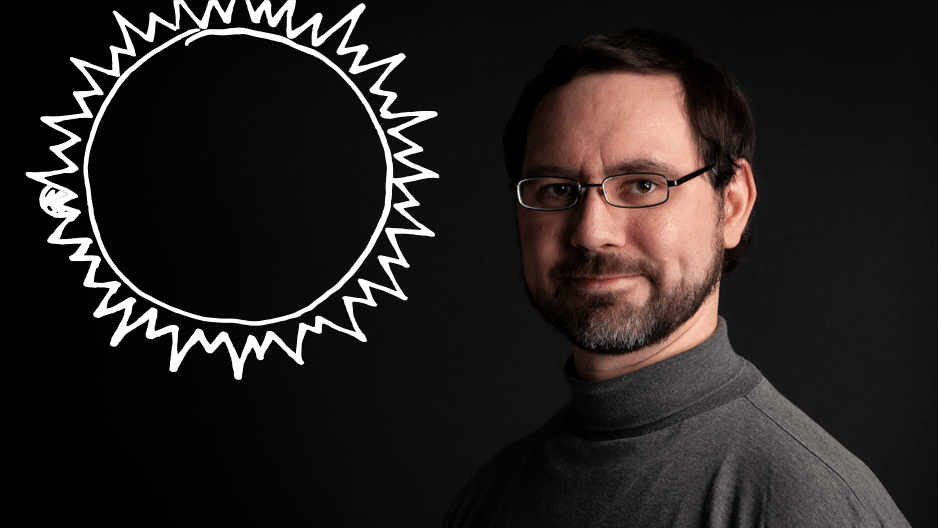Five minutes on ... the transit of Mercury, with an astrophysicist
We sat down with star faculty member and astrophysicist Matthew Newby to learn more about this rare astronomical event.

On Monday, Nov. 11, you will have an opportunity to witness a rare astronomical event: a transit of Mercury across the face of the sun. Join faculty and students of the College of Science and Technology on the fourth floor terrace of Charles Library for a view that we can most certainly describe as stellar.
In anticipation of this cosmic occurrence, we sat down with Matthew Newby, an assistant professor of physics, to learn why it’s such a big dipper … er … deal.
Nutshell: What is the significance of Mercury passing in front of the sun?
Newby: When a planet in our solar system passes in front of the sun from our perspective on Earth, it’s called a solar transit. This can only happen for Mercury and Venus, since they are the only planets orbiting closer to the sun than the Earth is (the technical term for this is “inferior planet”). And it’s a big deal because Mercury’s last solar transit was in 2016, and the next one won’t be until 2032.
Nutshell: Why do we have to wait so long for the next one?
Newby: Mercury overtakes or laps the Earth every 116 days. But since Mercury's orbit is tilted relative to the Earth’s, we only get to see Mercury pass directly between ourselves and the sun about once a decade (the time between one transit and the next is predictable, but varies by many years). So, in order to view Mercury’s transit, two things have to happen at the same time: Mercury has to be lapping the Earth, and Mercury’s orbit has to be crossing the Earth’s orbit.
Nutshell: The recent solar eclipse could only be viewed through special glasses or viewing apparatus. What are the safety considerations for viewing Mercury’s solar transit?
Newby: The safety considerations are the same for any type of solar viewing, including solar eclipses: Don’t stare at the sun without specialized, professional equipment! Just a few seconds of staring at the sun with the unaided eye can cause permanent vision damage (and possibly total blindness). Looking at the sun with any kind of non-specialized equipment can result in INSTANT, permanent blindness. The tools we use are professionally designed to safely view the sun—they are so specialized, in fact, that the sun is the ONLY thing you can see through them!
Nutshell: What do solar transits reveal?
Newby: Solar transits can help us discover new planets beyond our own sun. Astronomers look for a planet passing directly between its home star and our position in the galaxy—a transit—and identify “dips” in emitted starlight as evidence. If they see the same-shaped “dip” spread apart by the same amount of time multiple times, then they’ve found a planet! This transit method has been very effective, having found over 3,000 confirmed planets around other stars (out of over 4,000 currently known, in total).
Nutshell: Didn’t this year’s Nobel Prize go to researchers for using a similar method?
Newby: Half of the 2019 Nobel Prize in Physics was split between Michel Mayor and Didier Queloz for discovering the first known planet outside of our solar system (“51 Pegasi b”). They didn’t use the transit method, though. They used a technique called the “radial velocity method” that looks for small towards-and-away-from-us motions in distant stars. This “wobble” is evidence of another object (or objects) orbiting around the star in question. The radial velocity method had been used to find binary stars for a long time, but Mayor and Queloz made it sensitive enough to detect things much smaller than stars: planets! To date, the radial velocity method is the second most successful method for finding extrasolar planets, or those outside our own solar system.
Nutshell: What’s the most interesting thing about the transit of Mercury?
Newby: It gives us an opportunity to talk about astronomy and to put astronomical objects in perspective. Mercury will block some of the sun’s light from getting to us during its six-hour transit, though, the sun will seem about 16 parts per million dimmer than usual. So, to clarify, if you plan on soaking up the sun’s rays on the beach during these six hours, you’ll have to stay one second longer to get the same amount of sun as when there isn’t a transit.